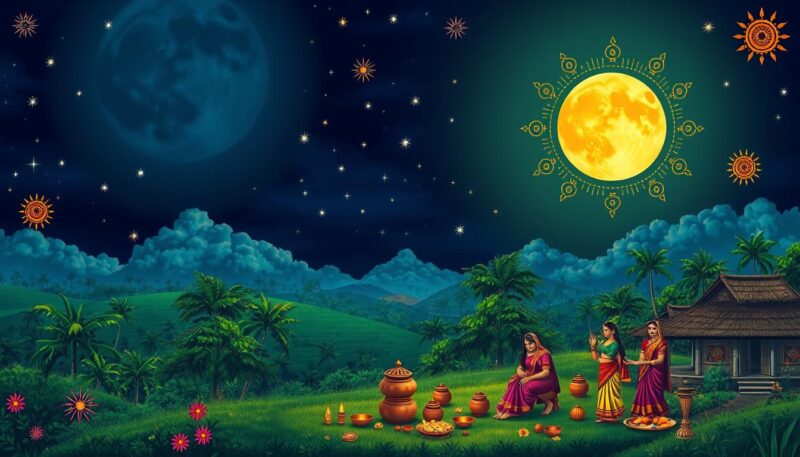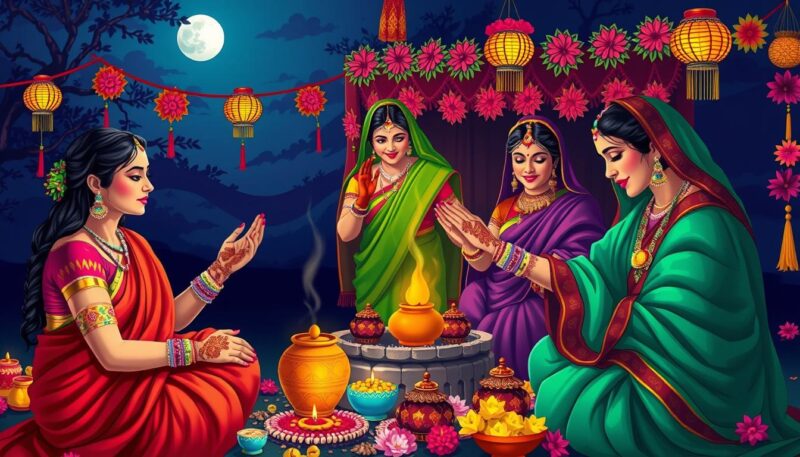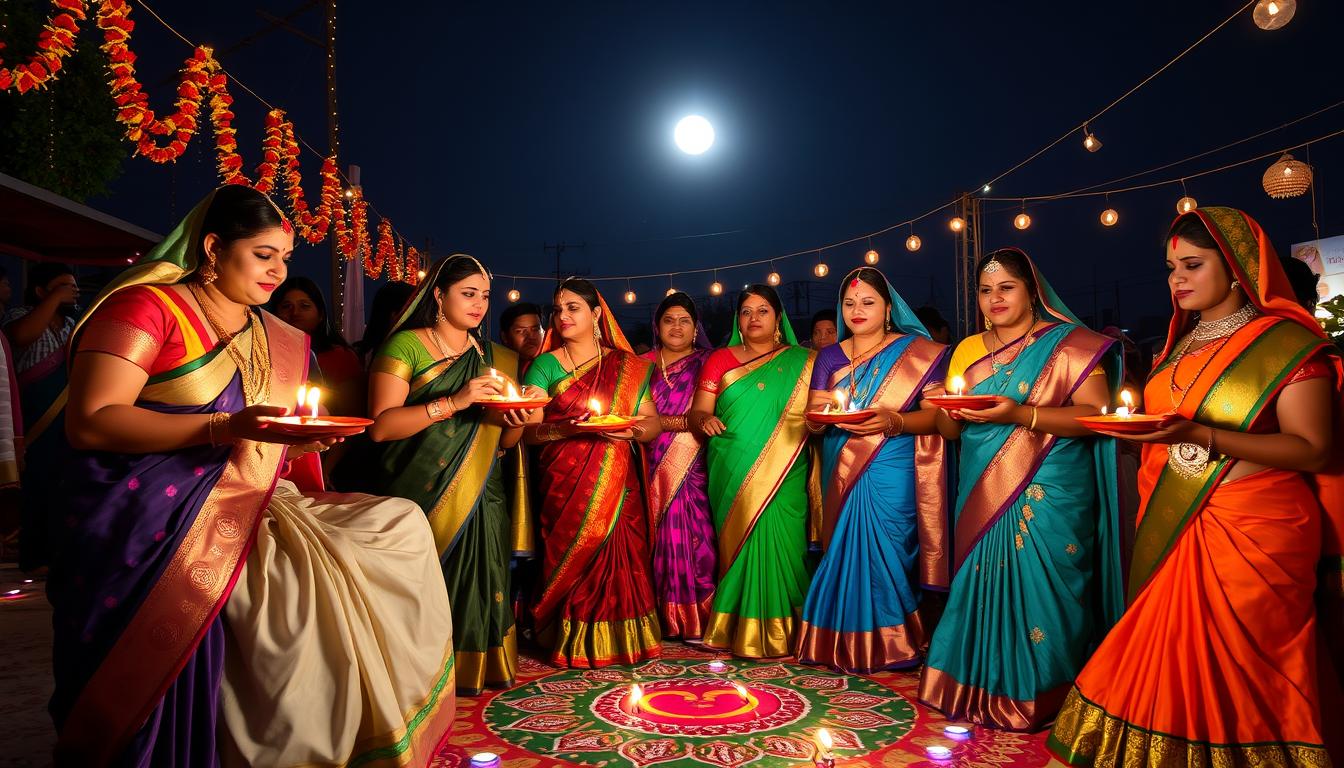Karva Chauth is an enchanting Indian festival rich in culture, tradition, and deep-rooted beliefs. Celebrated predominantly by married Hindu women in Northern and Western India, it reverberates with customs aimed at the well-being and longevity of their husbands. Observed on the fourth day after the full moon in the Hindu lunar month of Kartika, which usually falls in October or November, this festival is marked by fasting from sunrise to moonrise.
Imagine the vibrant hues of crimson and gold sarees, the scent of incense wafting in the air, and the sound of traditional prayers echoing through the house as women prepare for a day filled with dedication and devotion. The Karva Chauth festival is not just about rituals; it weaves an intricate tapestry of history, valor, and love, making it one of the most emotionally invested celebrations in the Indian cultural calendar.
Key Takeaways
- Karva Chauth is primarily observed by married women across India to pray for their husband’s longevity.
- The festival typically occurs in October or November, following the Hindu lunar calendar.
- Key practices include a full-day fast, community puja, and moon sighting to break the fast.
- Legends from the Mahabharata and other folklore emphasize the significance of a wife’s devotion and prayers.
- Queen Veervati’s tale illustrates the power of a woman’s fidelity and determination.
- The celebration fosters a sense of sisterhood through communal rituals and the exchange of gifts.
Introduction to Karva Chauth
Karva Chauth is a vibrant celebration predominantly observed by Hindu women in the Northern and Western regions of India. This one-day festival falls on the fourth day after the full moon in the Hindu lunar month of Kartika, typically occurring in October or November. It’s a deeply significant event that showcases the cultural practices in India, where married women participate in a day-long fast for the well-being and longevity of their husbands.
Origins and Historical Background
The historical background of Karva Chauth can be traced back to the time when Rajput men would go on military campaigns, and their wives would pray for their safe return. This festival aligns with the agrarian cycle as it coincides with the wheat-sowing time, suggesting a connection to agricultural fertility rituals. Celebrated in Northern Indian states such as Punjab, Haryana, Himachal Pradesh, Uttar Pradesh, and Rajasthan, the meaning of Karva Chauth is deeply embedded in the cultural and social fabric of these regions.
Participants engage in ceremonial practices like exchanging painted clay pots filled with bangles, ribbons, homemade candy, cosmetics, and small cloth items. The exchange of these karvas seven times between women marks an essential part of the ritual in states like Uttar Pradesh and Rajasthan. Additionally, during the festival, women gather in circles, singing songs and performing various rituals collectively, fostering a strong sense of community and mutual support.
Significance of Karva Chauth in Indian Culture
Karva Chauth holds immense significance as it’s a testimony to marital fidelity in Indian culture. On this day, women observe a ‘Nirjala’ fast, abstaining from both food and water the entire day. The ritual of fasting and praying for the husbands’ longevity symbolizes the devotion and selflessness inherent in Indian marriages. The communal aspect of the festival also strengthens ties among women, supporting one another through shared customs and reinforcing emotional bonds in forms such as “kangan-saheli” (friendship) or “dharam-behn” (sisterhood).
Moreover, the cultural practices in India, particularly on Karva Chauth, emphasize the traditional attire for Karva Chauth. Women typically wear saris or lehengas, adorned with jewelry and henna, making the festival not just a spiritual one, but also adding a festive and aesthetic vibe to the event. The traditional sargi meals consumed in the early hours of the day include an array of fresh fruits, dry fruits, sweets, chapatis, and vegetables, prepared with love and care.
Karva Chauth is not only a celebration of marital love but also a deep-rooted cultural practice in India that enhances the sense of community and tradition among women.
Traditions and Rituals of Karva Chauth
Karva Chauth is a festival steeped in age-old traditions and rituals symbolizing marital fidelity in Indian culture. This vibrant festival is primarily celebrated by Hindus and Sikhs in northern Indian states such as Punjab, Haryana, Rajasthan, Uttarakhand, Himachal Pradesh, Chhattisgarh, Madhya Pradesh, and Gujarat. Rooted in profound customs, the festival is known for its intricate women’s fasting rituals and devotional practices.
Fasting and Puja Practices
The essence of Karva Chauth lies in its rigorous fasting practices. Women observe a fast from dawn till moonrise, refraining from both food and water. These women’s fasting rituals are not just a testament to their devotion but also embody the intense nature of rituals during Karva Chauth. The day-long fast is coupled with special puja ceremonies where stories of Karva Chauth are narrated, and traditional songs are collectively sung.
Sargi and Pre-Dawn Preparations
The day of Karva Chauth begins early with the consumption of ‘Sargi,’ a pre-dawn meal provided by the mother-in-law. This meal includes fenia, fruits, and sweets, aimed at sustaining the women throughout the fasting period. The Sargi is a crucial component of Karva Chauth traditions, symbolizing the bond between the mother-in-law and daughter-in-law. Additionally, the evening puja involves offering baya (gifts) to the mother-in-law, further reinforcing the significance of familial relationships.
Women’s Attire and Adornments
On this auspicious day, women adorn themselves in fine attire, often choosing ceremonial garments like saris or lehengas. Frequently associated with Karva Chauth traditions, these garments are complemented by intricate jewelry and Mehndi (henna) designs, reflecting their marital status. The meticulous application of Mehndi and selection of new clothes for shringar embody the cultural richness and traditional aesthetics observed during this festival.
| Element | Details |
|---|---|
| Sargi | Pre-dawn meal including fenia, fruits, sweets. Provided by mother-in-law to sustain through the fast. |
| Fasting | No food or water from dawn till moonrise. A testament to women’s devotion and fidelity. |
| Evening Puja | Special prayers, narrating traditional stories, and singing songs to ensure the husband’s welfare and marital bliss. |
| Women’s Attire | Ceremonial garments like saris or lehengas, jewelry, and Mehndi indicating marital status. |
| Baya | Gifts from the mother-in-law to daughter-in-law, typically including money, clothes, jewelry, cosmetics, sindoor, and sweets. |
The Myths and Legends of Karva Chauth
The myths of Karva Chauth add a layer of cultural depth to this auspicious festival. Enriched by numerous folklore of Karva Chauth, these tales highlight timeless themes of love, devotion, and sacrifice. Here, we delve into a few of the most revered legends of Karva Chauth.

The Story of Queen Veervati
One of the most popular stories associated with Karva Chauth revolves around Queen Veervati. As per the myths of Karva Chauth, Queen Veervati was the only sister among seven loving brothers. On her first Karva Chauth after marriage, she observed a strict fast for her husband’s longevity. However, her brothers, unable to see her suffer from hunger, created a false moon using a mirror. Tricked by this illusion, Veervati broke her fast. Tragically, this led to her husband’s demise. Moved by her devotion, the gods granted her a boon, bringing her husband back to life.
The Tale of Satyavan and Savitri
The folklore of Karva Chauth includes the epic tale of Satyavan and Savitri. According to the story, Savitri was a devoted wife whose husband, Satyavan, was destined to die within a year of their marriage. Upon encountering Yama, the god of death, Savitri’s devotion and wit swayed him. She persistently followed Yama and engaged him in wise dialogue, eventually persuading him to revive Satyavan. This legend underscores the power of unwavering commitment and love, echoing the essence of Karva Chauth.
Other Popular Legends
Besides the tales of Veervati and Savitri, other legends of Karva Chauth enrich its cultural tapestry. One such story is that of a woman named Karwa, who saved her husband from a crocodile using her profound devotion and received boons from Yama. Another narrative involves Goddess Parvati and Lord Shiva, illustrating the virtues and immense power of a faithful wife. These stories associated with Karva Chauth highlight the significant role of women and their sacrifices, fostering a sense of unity and strength among them.
The festival’s various stories and rituals underscore the profound bonds of marital relationships and the cultural importance placed on the virtues of fidelity and commitment. Through the shared collective consciousness of these legends, Karva Chauth remains a vibrant celebration, transcending its traditional boundaries to resonate deeply with modern times.
What Is Karva Chauth?
Karva Chauth is a deeply revered festival observed by married women predominantly in the northern and western parts of India, celebrated for the well-being and prosperity of their husbands. Traditionally, the women undertake a strict fast from sunrise to moonrise, abstaining not just from food but also from water throughout the day. This fasting for husbands symbolizes unwavering dedication and love.
Over the years, numerous regional variations of Karva Chauth have emerged across states like Punjab and Uttar Pradesh. While some Karva Chauth customs remain universal—such as the sharing of rituals, folk songs, and the thali batana ceremony—other practices can vary significantly. For instance, the pre-dawn meal called Sargi, consisting mainly of fruits and potatoes with hot Puris, is a poignant reminder of maternal blessing and the beginning of the day’s observance.

Modern interpretations of Karva Chauth have also started taking root, reflecting the evolving dynamics of marital relationships. It’s not uncommon to find that some husbands reciprocate the gesture by fasting for their wives, embracing the festival’s spirit of mutual respect, love, and compassion. This shift signifies a broader acceptance of gender equality and emotional solidarity within marriages today.
Notably, the Karva Chauth customs and stories—such as those of Queen Veervati, Queen Draupadi, Karwa, and Satyavan and Savitri—play an essential role in reinforcing the festival’s cultural and emotional significance. These narratives, shared with great enthusiasm, highlight the virtues of devotion, love, and the fortitude of women, adding layers of meaning to the observance.
Despite these modern twists and regional variations of Karva Chauth, the core essence remains the same: it’s a celebration of marital love and a communal tradition that brings women together in shared solidarity. The festival continues to hold a special place, particularly for newly-wed women who don their bridal finery and partake in the festivities with great fervor.
Below is a table that captures the key aspects of Karva Chauth, illustrating its widespread observance and cultural significance:
| Aspect | Description |
|---|---|
| Regions Celebrated | Northern and Western India, especially Punjab and Uttar Pradesh |
| Timing | Fourth day of the dark fortnight in the Kartika month, usually in late October or early November |
| Main Customs | Fasting from sunrise to moonrise, storytelling, thali batana ceremony, Sargi meal |
| Modern Trends | Husbands also fasting, gifting, and mutual respect observed |
| Symbolic Significance | Love, respect, and the emotional bond between husband and wife |
Karva Chauth, with its unique blend of tradition, regional variations, and modern interpretations, stands as a testament to the endurance and adaptability of cultural practices, resonating deeply with those who partake in its rich, enduring legacy.
Conclusion
Karva Chauth gracefully illustrates the sanctity of marriage within Hindu culture, reflecting the profound values that underpin Indian cultural practices. This festival is more than a mere tradition; it is a celebration of marital fidelity, where fasting and prayer serve as powerful mediums to seek the well-being of loved ones. The rituals—ranging from the consumption of sargi at dawn to the elaborate puja at moonrise—foster a shared sense of purpose and spiritual devotion.
The myths and legends associated with Karva Chauth, such as the tales of Queen Veervati and Satyavan and Savitri, infuse the festival with layers of faith and divine intervention. These stories enrich the cultural narrative, emphasizing the importance of dedication and unwavering faith. According to the Padma Puran, the act of observing the Karva Chauth fast holds spiritual significance and is essential for atonement, extending beyond just married women to include men, widows, and various other groups.
As modernity coexists with tradition, Karva Chauth continues to be a deeply revered festival in India. It not only symbolizes the longevity of a husband’s life but also underscores the importance of respecting familial bonds. Through its customs—like the detailed sargi preparation, the wearing of bridal attire, and the collective prayer rituals—Karva Chauth remains a testament to the enduring celebration of marital fidelity and the collective ethos of Indian society.
FAQ
What Is Karva Chauth?
Karva Chauth is a traditional Hindu festival primarily celebrated by married women in Northern and Western India. On this day, women fast from sunrise to moonrise to pray for the safety and longevity of their husbands.
What are the myths and legends surrounding Karva Chauth?
Some of the myths and legends include the story of Queen Veervati, who was deceived into breaking her fast; the tale of Satyavan and Savitri, where Savitri’s faithfulness revived her husband; and the legend of Karwa, who saved her husband from a crocodile with her devotion.
What is the significance of Karva Chauth in Indian culture?
The significance lies in its celebration of marital fidelity and the deep bond of marriage. It also fosters communal solidarity among women through shared rituals, emphasizing mutual support and traditional cultural practices.
How did Karva Chauth originate?
The origins trace back to the time of Rajput warfare, where women prayed for their husbands’ safe return from military campaigns. It also coincides with the wheat-sowing season, suggesting a connection to agricultural fertility rituals.
What are the fasting and puja practices during Karva Chauth?
Women observe a strict fast from sunrise to moonrise without food or water. The day includes special puja (prayers), storytelling, and collective singing of traditional songs.
What is ‘Sargi,’ and what is its significance?
Sargi is a pre-dawn meal provided by the mother-in-law that includes fenia, fruits, and sweets to sustain women during the fast. It’s an integral part of Karva Chauth preparations.
What traditional attire do women wear for Karva Chauth?
Women often dress in fine ceremonial garments like saris or lehengas and adorn themselves with jewelry and Mehndi, symbolizing their marital status.
What is the story of Queen Veervati?
Queen Veervati was misled by her brothers into breaking her fast early, which led to her husband’s demise. Her unwavering devotion prompted the gods to restore her husband’s life.
What is the tale of Satyavan and Savitri?
Savitri’s profound commitment and wit persuaded Yama, the god of death, to revive her deceased husband, Satyavan. It underscores the virtue of a faithful wife.
Are there regional variations of Karva Chauth?
Yes, there are regional variations in customs and rituals. However, core practices like fasting, puja, and prayers to the moon remain constant across different regions in India.
How is Karva Chauth interpreted in modern times?
Modern interpretations include husbands partaking in the fast, signifying mutual respect and love. Despite evolving customs, the festival retains its essence of celebrating marital devotion and love.
Source Links
- https://www.herzindagi.com/society-culture/karwa-chauth-2023-tales-legends-festival-article-250447
- https://www.indiatoday.in/lifestyle/culture/story/karva-chauth-legends-myths-hindu-married-women-fasting-veeravati-shiva-parvati-lifest-1058937-2017-10-06
- https://en.wikipedia.org/wiki/Karva_Chauth
- http://indianculture.gov.in/stories/karva-chauth
- https://timesofindia.indiatimes.com/life-style/events/karwa-chauth-2021-important-rituals-to-follow-while-celebrating-this-festival/articleshow/87218897.cms
- https://www.bollywoodshaadis.com/articles/the-beautiful-rituals-of-karva-chauth-that-every-woman-should-know-about-5656
- https://www.firstpost.com/living/mythology-for-the-millennial-on-the-absurdity-around-karwa-chauth-and-blaming-women-for-every-wrong-7500341.html
- https://timesofindia.indiatimes.com/life-style/parenting/moments/karwa-chauth-2022-stories-on-karwa-chauth-festival-every-kid-should-know/photostory/94811495.cms
- https://www.hennaarts.com/significance-of-karwa-chauth-vrat-vidhi.htm
- https://www.fnp.com/article/karwa-chauth?srsltid=AfmBOopPdHeyVwRm-rXaPuFqfVkO42x9qwfBvbc_1gBT1q1CKuu8-Jpp
- https://www.lokvani.com/lokvani/article.php?article_id=11521
- https://tokenz.com/blogs/tokenz/why-do-we-celebrate-karwa-chauth

